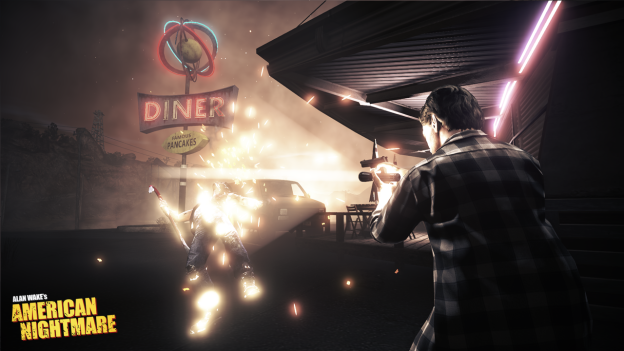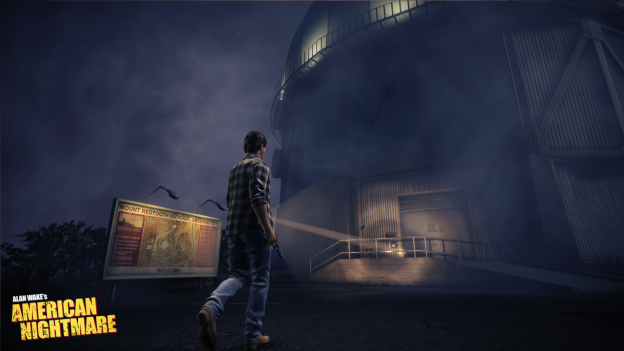
Whatever you’re expecting from Alan Wake’s American Nightmare, just forget it. While the standalone Xbox Live Arcade release that Remedy has set for early next year shares plenty of common ground with 2010’s long-delayed and super-fun Alan Wake, the tone of things in the coming release takes a very sharp turn away from the older game’s serial TV drama feel. I learned as much last week when I got to check out a hands-off taste of the story mode and a hands-on runthrough of the game’s new survival mode, Fight Till Dawn.
That survival mode is actually the reason American Nightmare even exists, Remedy’s Oskari ‘Os’ Häkkinen and Matias Myllyrinne told me during last week’s demo. It grew out of a “white room” test of the first game’s combat system, which is built around using a flashlight to cleanse enemies of their darkness and make them vulnerable to Alan’s more standard weapons. The Remedy team eventually started to get competitive with this tech demo, until the realization eventually struck that this could be a fun thing for gamers to play with as well.
From there it was a matter of fleshing out the mode and making it something more than just Alan Wake trying to survive in an empty room filled with weapon drops. Five maps were created, all of them inspired by but not directly replicating familiar Wake environments. New weapons were added, and a combo system that allows players to rack up points as they play. A story was added eventually, and although it exists in a completely separate mode, it, too, is inspired by the action-minded sensibilities of Fight Till Dawn.
Alan Wake’s next adventure in American Nightmare is a spin-off in the truest sense of the word. There will be links to the larger story (and presumably hints toward what is to come), but the XBLA game’s story unfolds entirely within the confines of an episode of Night Springs, the Alan Wake world equivalent of The Twilight Zone. Alan apparently wrote a few episodes of the show early in his career, and now he’s forced to live out one of them.

The story portion of the game opens with a cutscene in which we see Alan’s agent Barry, now working with the band Old Gods of Asgard (real life band Poets of the Fall), who you may remember from the previous game. Barry has fallen asleep in his motel room with the TV on; the camera zooms in tighter and tighter on the screen until we see nothing but static, which soon gives way to the Night Springs intro. It’s not clear how else Barry ties into the story or if we’ll be seeing him again later on in American Nightmare, but Remedy promises some “real”-world catch-up in this spinoff story on where the series’ key players are currently at.
Myllyrinne boils down the game’s newfound action focus into a simple tagline: “If Alan Wake was all about the pen being mightier than the sword, then American Nightmare is more the nailgun is mightier than the sword.” The nailgun is indeed one of the new weapons you’ll use, along with an assault rifle, an uzi, a sawed off shotgun and a darkness-piercing crossbow (no flashlight required for that last one).
We can look to examples like Lost in trying to understand what inspired Wake, whereas American Nightmare has more in common with Quentin Tarantino and over-the-top grindhouse fiction. This is evident as soon as the game enters the world of Night Springs, with a grainy visual filter that makes the brighter colors pop much more than they did in the dark and moody original. Wake is also no longer the narrator, replaced in American Nightmare by — who else? — the Night Springs Rod Serling-alike.
The spinoff story follows Wake, the so-called Champion of Light, as he pursues his evil doppelganger Mr. Scratch, the Herald of Darkness. Arizona is the setting, allowing for more wide-open environments than we saw in the first game. In fact, the story portion of American Nightmare is actually a hub-based open world, with three central locations in all.

Unfortunately, I didn’t get to see the more open elements in action. My demo focused on two sections of story that could just as easily have come from a game inspired by the linear design of the previous Wake. In the first bit, Alan is attempting to recreate the conditions of a scene from the episode he wrote in order to create some sort of weapon that can be used against Mr. Scratch. It’s a cool moment, involving an asteroid, a crashing satellite, an oil derrick and a large, fiery explosion, all of it backed by the same sort of melodic heavy metal that punctuated so much of the previous game.
The second bit I saw showcased more of the story, with Alan heading up a rocky hill toward an observatory where he’ll be meeting with Dr. Meadows, one of the three notable figures who will be aiding him in American Nightmare. It’s a linear gauntlet up the hill, with Alan pausing only to fight enemies and avoid obstacles like a thrown pickup truck or a conveniently timed rockslide. The sequence culminates with Alan fending off Mr. Scratch’s lackeys inside the observatory while he waits for Dr. Meadows to get power to the lights, a moment that my Remedy tour guides compare with Wake‘s “concert” scene.
It’s not all same old, same old, of course. The new weapons I already mentioned. Collectibles return in the form of manuscript pages, only this time they’ll unlock more than just Achievements. Throughout the game — both the story mode and the Fight Till Dawn mode — you’ll come across locked weapon crates that can only be opened if you’ve found the correct number of manuscript pages. In addition to all of that, there are also some new enemies for Alan to take on.
I saw three of them in all. The first is a large, thuggish beast of a dark power-infused man. You won’t need to zap him with your flashlight in order to do damage, but you might want to since, in his default state, he’s both powerful and hardy. Zapping the brute with your flashlight causes him to split into two smaller brutes; they’re weaker, but faster. That pair can then be split again, resulting in a foursome of enemies that are all very weak, yet extremely agile.
Also among the more nimble enemies you’ll encounter is a birdman. Why is he called that? Focus too much fire in his direction and he’ll dodge away, transforming into a flock of birds that flies off to a new location before re-assuming a humanoid form. Also new to the Wake rogue’s gallery is a grenade-chucking enemy. No mysteries here; it throws an explosive device, you move out of the way quickly or take splash damage.

Fight Till Dawn mode ditches the story while bringing everything else together. It’s a score-based gauntlet in which you, as Alan, must survive for 10 real-life minutes as a clock ticks down toward dawn. Enemies attack in waves which increase in both difficulty and variety as you progress. Weapon, ammo and grenade pickups are scattered throughout the five maps (finishing the story unlocks those same five on Nightmare difficulty); you can also recover health by stepping into a pool of light, though each light shorts out once it is used. If you’re looking for an easy comparison, it’s like the concert sequence from Alan Wake, only with a much larger playing field.
The idea in Fight Till Dawn is to earn points by killing enemies and not taking damage. You build up combo multipliers as you earn points without being hit, which adds a bit more pressure to that 10-minute countdown. Sure, you could easily survive by just running around in a big circle while dodging attacks from the opening wave of enemies, but you won’t score many points that way. Survival is important, but the key focus in Fight Till Dawn is on earning points.
I took several cracks at the survival mode before I developed a strong enough strategy to last until sunrise. The controls seem tighter than they were in the last game, but the abundance of weapons pickups and wider variety of enemies helped to keep the surprises coming as I fought to keep Alan alive. Sure, there’s not a TON of replay value here if leaderboards aren’t your thing, but Fight Till Dawn seems to offer an entertaining diversion that embraces and expands upon some of the best aspects of the franchise’s gameplay.
Stay tuned for more tomorrow on Alan Wake’s American Nightmare from my follow-up chat with Häkkinen and Myllyrinne.
Editors' Recommendations
- Alan Wake is coming to Dead by Daylight later this month
- Alan Wake 2 studio is rebooting its upcoming multiplayer project
- All TV locations in Alan Wake 2
- The best weapon upgrades in Alan Wake 2
- All charm locations and effects in Alan Wake 2


